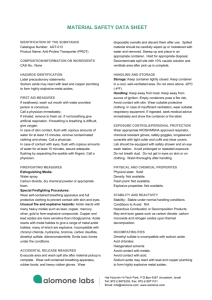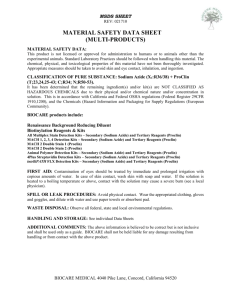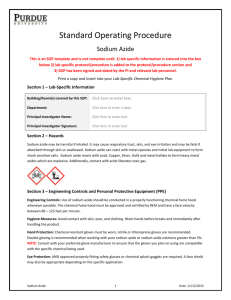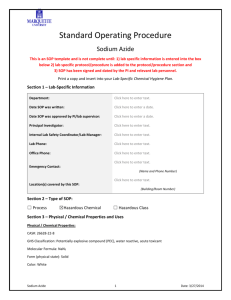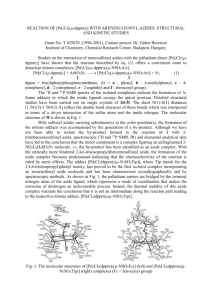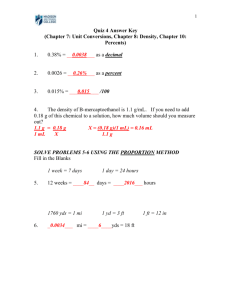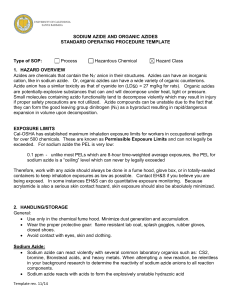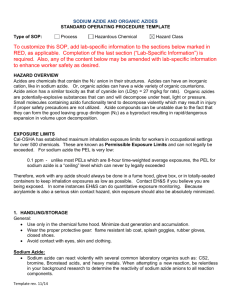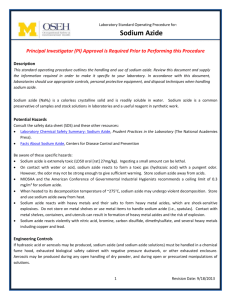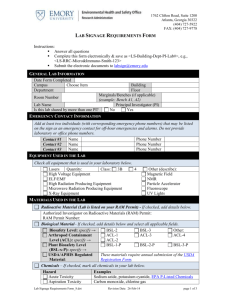Sodium Azide - WSU Environmental Health & Safety
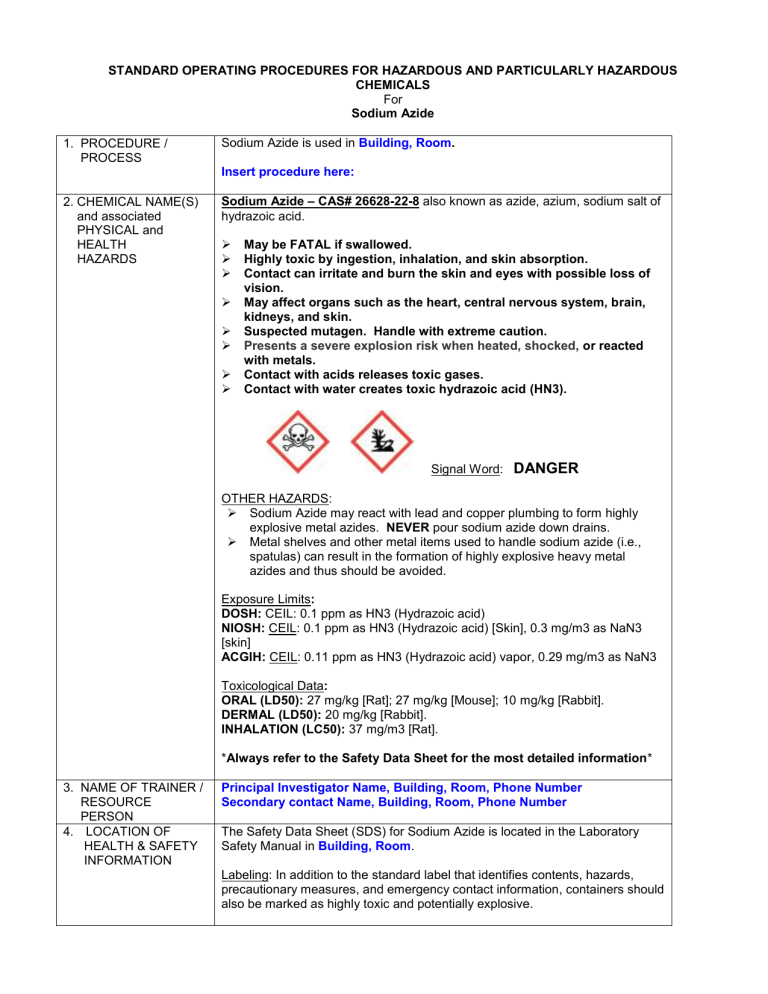
STANDARD OPERATING PROCEDURES FOR HAZARDOUS AND PARTICULARLY HAZARDOUS
CHEMICALS
For
Sodium Azide
1. PROCEDURE /
PROCESS
2. CHEMICAL NAME(S)
and associated
PHYSICAL and
HEALTH
HAZARDS
Sodium Azide is used in
Insert procedure here:
Building, Room .
Sodium Azide – CAS# 26628-22-8 also known as azide, azium, sodium salt of hydrazoic acid.
May be FATAL if swallowed.
Highly toxic by ingestion, inhalation, and skin absorption.
Contact can irritate and burn the skin and eyes with possible loss of vision.
May affect organs such as the heart, central nervous system, brain, kidneys, and skin.
Suspected mutagen. Handle with extreme caution.
Presents a severe explosion risk when heated, shocked, or reacted with metals.
Contact with acids releases toxic gases.
Contact with water creates toxic hydrazoic acid (HN3).
Signal Word:
DANGER
OTHER HAZARDS:
Sodium Azide may react with lead and copper plumbing to form highly explosive metal azides. NEVER pour sodium azide down drains.
Metal shelves and other metal items used to handle sodium azide (i.e., spatulas) can result in the formation of highly explosive heavy metal azides and thus should be avoided.
Exposure Limits :
DOSH: CEIL: 0.1 ppm as HN3 (Hydrazoic acid)
NIOSH: CEIL: 0.1 ppm as HN3 (Hydrazoic acid) [Skin], 0.3 mg/m3 as NaN3
[skin]
ACGIH: CEIL: 0.11 ppm as HN3 (Hydrazoic acid) vapor, 0.29 mg/m3 as NaN3
Toxicological Data :
ORAL (LD50): 27 mg/kg [Rat]; 27 mg/kg [Mouse]; 10 mg/kg [Rabbit].
DERMAL (LD50): 20 mg/kg [Rabbit].
INHALATION (LC50): 37 mg/m3 [Rat].
* Always refer to the Safety Data Sheet for the most detailed information *
3. NAME OF TRAINER /
RESOURCE
PERSON
Principal Investigator Name, Building, Room, Phone Number
Secondary contact Name, Building, Room, Phone Number
4. LOCATION OF The Safety Data Sheet (SDS) for Sodium Azide is located in the Laboratory
HEALTH & SAFETY Safety Manual in Building, Room .
INFORMATION
Labeling: In addition to the standard label that identifies contents, hazards, precautionary measures, and emergency contact information, containers should also be marked as highly toxic and potentially explosive.
5. PROTECTIVE
EQUIPMENT
Wear chemical safety goggles, nitrile rubber gloves, and a fully buttoned lab coat. Work within a properly functioning, certified laboratory chemical fume hood. If using outside of fume hood correct PPE and an approved, certified respirator with the correct cartridges should be worn. ( Note : You must be medically cleared, fit tested and enrolled in WSU’s respiratory protection program to wear a respirator).
6. WASTE DISPOSAL
PROCEDURES
Waste Sodium Azide in pure form must be managed as Dangerous Waste. It should be collected in a sealable, compatible waste container. The container should be stored away from incompatible materials such as metals, acids, benzoyl chloride, potassium hydroxide, bromine, carbon disulfide, chromyl chloride, copper, dibromalononitrile, dimethyl sulfate, lead, barium carbonate, sulfuric acid, water, and nitric acid.
A completed Dangerous Waste label should be attached when waste is first added to the container. When container is full or no longer being used complete a Chemical Collection Request Form, and deliver to the Waste
Accumulation Area Operator at Building, Room, Phone Number.
Waste Sodium Azide solutions greater than 0.01% or 100 ppm must be managed as Dangerous Waste. It should be collected in a sealable, compatible waste container. The container should be stored away from incompatible materials such as metals, acids, benzoyl chloride, potassium hydroxide, bromine, carbon disulfide, chromyl chloride, copper, dibromalononitrile, dimethyl sulfate, lead, barium carbonate, sulfuric acid, water, and nitric acid.
A completed Dangerous Waste label should be attached when waste is first added to the container. When container is full or no longer being used complete a Chemical Collection Request Form, and deliver to the Waste
Accumulation Area Operator at Building, Room, Phone Number. Solutions containing less than 0.01% sodium azide may be drain discharged.
Empty Sodium Azide containers must be managed as Dangerous Waste. Do not rinse out the container, simply attach a completed Dangerous Waste label, complete a Chemical Collection Request Form, and deliver to the Waste
Accumulation Area Operator at Building, Room, Phone Number.
7. DESIGNATED AREA The sodium azide is stored and dispensed in Building, Room .
INFORMATION
Always work in a properly functioning, certified laboratory chemical fume hood. Use process enclosures, local exhaust ventilation, or other engineering controls to reduce dust/aerosol generation.
If used outside of enclosure ensure that appropriate certified respiratory protection and PPE is worn. ( Note : You must be medically cleared, fit tested and enrolled in WSU’s respiratory protection program to wear a respirator).
Caution! Explosions in laboratory plumbing containing these metals is possible. Sensitive to mechanical impact. Decomposes explosively upon heating, shock, concussion, or friction. Reacts with both copper and lead to produce explosive azides.
The designated area(s) should be shown on the floor plan in Laboratories
Chemical Hygiene Plan.
8. DECONTAMINATION Upon Accidental Exposure:
PROCEDURES In case of eye contact , flush eyes with copious amounts of water at an emergency eyewash station for at least 15 minutes and seek medical attention.
In case of skin contact , flush skin with copious amounts of water for 15
minutes and seek medical attention. For exposure over a large portion of the body, remove clothing and shoes and rinse thoroughly in an emergency shower for at least 15 minutes. Seek medical attention.
In case of inhalation , move person to fresh air and immediately seek medical attention.
In case of ingestion , immediately seek medical attention and follow instructions on SDS.
Upon Accidental Release :
Large Spill : If a large amount of sodium azide is spilled, immediately evacuate, secure area and call 911 to contact EH&S.
Small Spill : If a small amount of sodium azide is spilled (it can be cleaned up in 10 minutes) and you have been properly trained to clean it up, you may do so. Secure and ventilate the area of leak or spill. Trained workers must wear appropriate personal protective equipment and clothing including fully buttoned lab coat, safety goggles, nitrile gloves and respirator. (Note: You must be medically cleared, fit tested, and en rolled in WSU’s respiratory protection program to wear a respirator).
Use appropriate tools to put the spilled solid in a waste disposal container.
Ensure all rinsate is also contained and not allowed to go down the drains or into the septic system. Place waste in appropriate containers and dispose of as hazardous waste (see above WASTE DISPOSAL PROCEDURES).
As with all accidents, report any exposure as soon as possible to your Principal
Investigator or Supervisor. Additional health and safety information on Sodium
Azide can be obtained by referring to the Safety Data Sheet or by calling the
EH&S Office (335-3041).
9. SPECIAL STORAGE Caution! Explosions in laboratory plumbing containing these metals is
AND HANDLING
PROCEDURES possible. Sensitive to mechanical impact. Decomposes explosively upon heating, shock, concussion, or friction. Reacts with both copper and lead to produce explosive azides.
Store in secondary containment with “Acute Toxin” label on the primary container, secondary containment and the storage location. Keep containers tightly closed in a dry, cool, and well-ventilated place away from sources of heat or ignition. Do not store on metal shelves or use metal items (spatulas) to handle sodium azide. Store segregated from incompatible chemicals (below).
Sodium azide powder should be purchased in the smallest practical amount.
Make stock solutions of 10%, if possible to minimize potential accidents.
Whenever handling pure sodium azide powder or concentrated solutions of
10% or more that may require assistance in case of a spill or accident, it is recommended that a second trained individual be present in the lab or in the vicinity.
Keep away from incompatible materials such as metals, acids, benzoyl chloride, potassium hydroxide, bromine, carbon disulfide, chromyl chloride, copper, dibromalononitrile, dimethyl sulfate, lead, barium carbonate, sulfuric acid, water, and nitric acid. Contact with acids releases toxic gases.
Certification of Hazard Assessment
Is this document a certification of Hazard Assessment for the processes identified within?
Yes No
If yes, provide the name of the person certifying the Hazard Assessment and the date it was performed:
____________________________________________________________________________________
Name Date
The location of the Hazard Assessment is indicated in the document preceding this form.
Certificate of Employee Training
Name of person providing training for employees working with this process:
___________________________________________________________________________________
The following employees have been trained in when, where and how to use selected PPE, the maintenance, limitations and disposal of the PPE selected, and have demonstrated the correct use of the PPE selected on the reverse of this certification.
Name Date Trained
________________________________________ _______________________________
________________________________________ _______________________________
________________________________________ _______________________________
________________________________________ _______________________________
________________________________________ _______________________________
________________________________________ _______________________________
________________________________________ _______________________________
